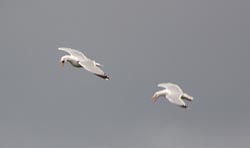 January, often associated with bitter cold weather and relative inactivity across much of the plant and animal kingdoms, was unusually mild, wet and occasionally very windy, resulting in complex and rapidly changing weather conditions. One moment it was bright and sunny, then in the next the rain was falling, only to stop just as suddenly.
January, often associated with bitter cold weather and relative inactivity across much of the plant and animal kingdoms, was unusually mild, wet and occasionally very windy, resulting in complex and rapidly changing weather conditions. One moment it was bright and sunny, then in the next the rain was falling, only to stop just as suddenly.
As a result, many insects were still active, with even the occasional bumble bee in flight. Some birds appeared to have started territorial singing. There were signs of bud-burst in native shrubs such as honey suckle.
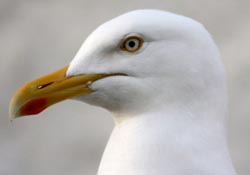 By mid-month the Roseland was experiencinggales of east wind. It’s a joy to watch the herring gulls (Larus argentatus) in these conditions. They appear to derive great pleasure from the updraught as the wind hits the coast, displaying consummate agility and skill in the face of the strongest gale. Despite their perceived ubiquity, populations of these magnificent birds have been in significant decline in the last 25 years, to the extent that they are now red listed by the RSPB. Last year it was noted that, anecdotally, Roseland gulls did not appear to have had much reproductive success. This is something to watch for in the coming reproductive season. Principally scavengers and therefore detrivores, gulls are vital to the great cycle of life, contributing to the recycling of waste products. Without detrivores, we would be buried in waste material and have no elemental nutrients to put back into the system.
By mid-month the Roseland was experiencinggales of east wind. It’s a joy to watch the herring gulls (Larus argentatus) in these conditions. They appear to derive great pleasure from the updraught as the wind hits the coast, displaying consummate agility and skill in the face of the strongest gale. Despite their perceived ubiquity, populations of these magnificent birds have been in significant decline in the last 25 years, to the extent that they are now red listed by the RSPB. Last year it was noted that, anecdotally, Roseland gulls did not appear to have had much reproductive success. This is something to watch for in the coming reproductive season. Principally scavengers and therefore detrivores, gulls are vital to the great cycle of life, contributing to the recycling of waste products. Without detrivores, we would be buried in waste material and have no elemental nutrients to put back into the system.
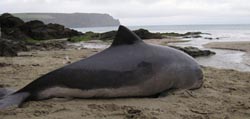 One of the first cetacean casualties of the new year was reported early in January, when volunteer members of the marine strandings team were called out to assess a very freshly dead male harbour porpoise (Phocoena phocoena) at Carne beach. These cetaceans are very small compared to larger relatives like dolphins. They prefer to frequent shallower waters in social groups, their main source of nutrition being fish such as herring and mackerel, as well as some crustacea, which can leads them into conflict with human fishing activity. The main threats to the porpoises way of life are: entanglement in fishing nets and lines, chemical and noise pollution, boat traffic, hunting and lack of food resources.
One of the first cetacean casualties of the new year was reported early in January, when volunteer members of the marine strandings team were called out to assess a very freshly dead male harbour porpoise (Phocoena phocoena) at Carne beach. These cetaceans are very small compared to larger relatives like dolphins. They prefer to frequent shallower waters in social groups, their main source of nutrition being fish such as herring and mackerel, as well as some crustacea, which can leads them into conflict with human fishing activity. The main threats to the porpoises way of life are: entanglement in fishing nets and lines, chemical and noise pollution, boat traffic, hunting and lack of food resources.
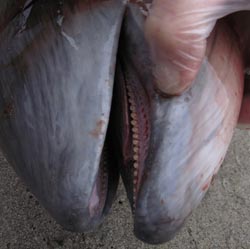 The porpoise repoted at Carne was a juvenile, measuring some 1.2 metres, and thus not quite fully grown. Nonetheless it probably weighed in excess of 30 Kilos, and was a heavy and challenging shape for two people to pick up and load into a car for post mortem (PM) at the Animal Health and Veterinary Laboratory Agency (AHVLA), Polwhele, Truro. it’s really important to PM the corpses of stranded marine animals, as this can tell us a huge amount about their existence, as well as the effect of human behaviour on their health and wellbeing. PMs can also help to reveal the presence of zoonotic disease pathogens and thus the risk posed to human health. AHVLA Truro is currently threatened with closure as part of government austerity measures. Future PMs may therefore have to be carried out in London, leading to a reduction in this vital research, due to the various constraints of transportation (cost, time, resource availability, degradation of samples).
The porpoise repoted at Carne was a juvenile, measuring some 1.2 metres, and thus not quite fully grown. Nonetheless it probably weighed in excess of 30 Kilos, and was a heavy and challenging shape for two people to pick up and load into a car for post mortem (PM) at the Animal Health and Veterinary Laboratory Agency (AHVLA), Polwhele, Truro. it’s really important to PM the corpses of stranded marine animals, as this can tell us a huge amount about their existence, as well as the effect of human behaviour on their health and wellbeing. PMs can also help to reveal the presence of zoonotic disease pathogens and thus the risk posed to human health. AHVLA Truro is currently threatened with closure as part of government austerity measures. Future PMs may therefore have to be carried out in London, leading to a reduction in this vital research, due to the various constraints of transportation (cost, time, resource availability, degradation of samples).
The porpoise we picked up at Carne had been a fit and healthy individual before losing his life. There were no signs of disease or malnutrition anywhere; the dentition appeared perfect. However, evidence of how he died was strongly suggested by deep cuts and encirling marks to the tail flukes. This individual was probably bycaught – drowned when entangled by fishing net or fishing lines.
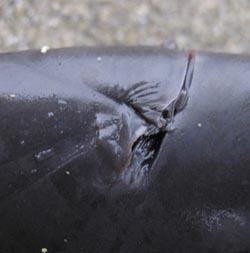 The Roseland was buffeted by strong easterly gales mid-month, which delivered another victim, this one alive – a weaner male seal pup. He beached at Porthcurnick, probably through shear exhaustion after fighting the rough surge. Seals are not normally seen hauled out on this beach, which is too accessible from the land by humans and their dogs. With a badly infected rear flipper, the weaner’s chances of survival were poor because he would not be able to swim effectively and catch fish prey, which at his young age he was still learning about. Fortunately the pup was discovered before the return of the tide; he was guarded from over-curious humans and dogs until he could be captured and taken to the National Seal Sanctuary at Gweek.
The Roseland was buffeted by strong easterly gales mid-month, which delivered another victim, this one alive – a weaner male seal pup. He beached at Porthcurnick, probably through shear exhaustion after fighting the rough surge. Seals are not normally seen hauled out on this beach, which is too accessible from the land by humans and their dogs. With a badly infected rear flipper, the weaner’s chances of survival were poor because he would not be able to swim effectively and catch fish prey, which at his young age he was still learning about. Fortunately the pup was discovered before the return of the tide; he was guarded from over-curious humans and dogs until he could be captured and taken to the National Seal Sanctuary at Gweek.
Weaner pups and even neonate white-coats look vulnerable and helpless and human nature prompts the caring curious get close to investigate. However, these young animals are far more agile than their landed state suggests. They will always try to bite when they feel threatened. A specific antibiotic is required to prevent the onset of ‘seal finger’, a mycoplasma infection resulting from seal bites or even just from touching a seal. Thus, when Dave Jarvis of British Divers Marine Life Rescue approached, he did so with experienced caution. The plan was to pin down the pup for a quick health assessment before transfer to the rescue transport. All involved wore gloves. In the event it took three of us to anchor all moving parts, and Dave at the head end got bitten through a glove. So if you ever find a seal pup on the beach, do not attempt contact but follow the straightforward instruction available here from BDMLR. If you have any cause for concern, contact BDMLR and they will be glad to advise on the situation.
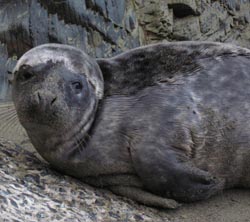 The weaner pup rescued at Porthcurnick has been recovering well at Gweek and is eating fish without force feeding. Staff have apparently named him Carwardine, in honour of the scientist writer and TV presenter Mark Carwardine. When the pup has reached optimum weight to survive back in the wild, he will be released.
The weaner pup rescued at Porthcurnick has been recovering well at Gweek and is eating fish without force feeding. Staff have apparently named him Carwardine, in honour of the scientist writer and TV presenter Mark Carwardine. When the pup has reached optimum weight to survive back in the wild, he will be released.
With the approach of February, here are some things you can do to help nature in the Roseland:
Support the campaign to keep the AHVLA facility in Cornwall.
There will be a public meeting held from 2pm on 6th February at the Inn For All Seasons, Treleigh, Redruth, TR16 4AP. The meeting has been organized by Cornwall Wildlife Trust Marine Strandings Network, British Divers Marine Life Rescue, Cornwall Seal Group and the National Seal Sanctuary.
Keep putting out food for birds.
Even farmland birds may be considering visiting gardens. Many of the weedy stubbles they forage in have been sprayed to kill the seedy weeds.
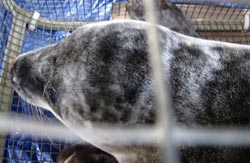 Hedgehog survey seeks public help
Hedgehog survey seeks public help
There are hedgehogs in the Roseland – we’ve all seen them squashed on the highway, but where do they all hide out? According to Cornwall Mammal Group there are no hog sightings recorded for the Roseland Peninsula. The People’s Trust for Endangered Species (PTES) and the British Hedgehog Preservation Society (BHPS) are calling on the public to take part in an online survey of hedgehogs, to see if climate change is affecting their hibernation and survival. You can do your bit to prove hogs live in the Roseland by signing up to the survey here and by telling Cornwall Mammal Group when and where you have seen them.
Continue to keep a look out for unusual occurrences resulting from the mild winter. Tell us at RO and we may mention it in next month’s review!
References
Arkive (2012) Harbour Porpoise
http://www.arkive.org/harbour-porpoise/phocoena-phocoena
Cawardine, M. (1995) Whales, Dolphins and Porpoises. Dorling Kindersley. London.
Carwardine, M., Hoyt, E., Fordyce, R.E. and Gill, P. (1998) Whales and Dolphins, the Ultimate Guide to Marine Mammals. Harper Collins. London.
Dolphincare UK (2012) Harbour porpoise. http://www.dolphincareuk.org/harbour.html
White, C.P. and Jewer, D.D. (2009) Seal finger: A case report and review of the literature. Can. J. Plast. Surg. 17(4): 133–135.
RSPB (2012) Herring Gull.
http://www.rspb.org.uk/wildlife/birdguide/name/h/herringgull/index.aspx
WDCS (2012)
http://www.wdcs.org
Sarah Vandome
